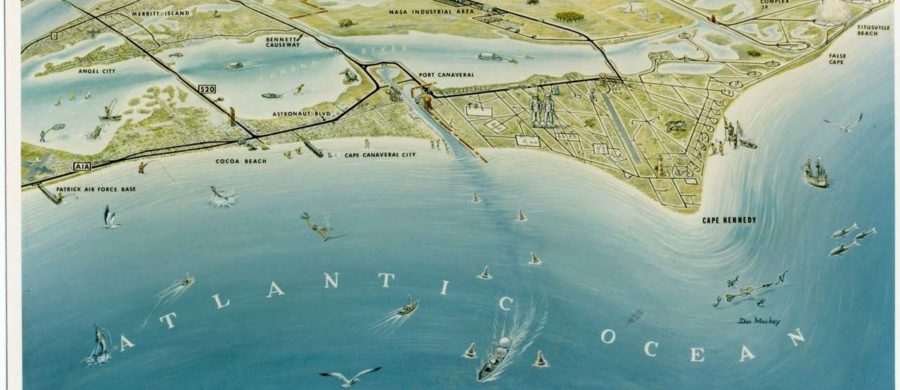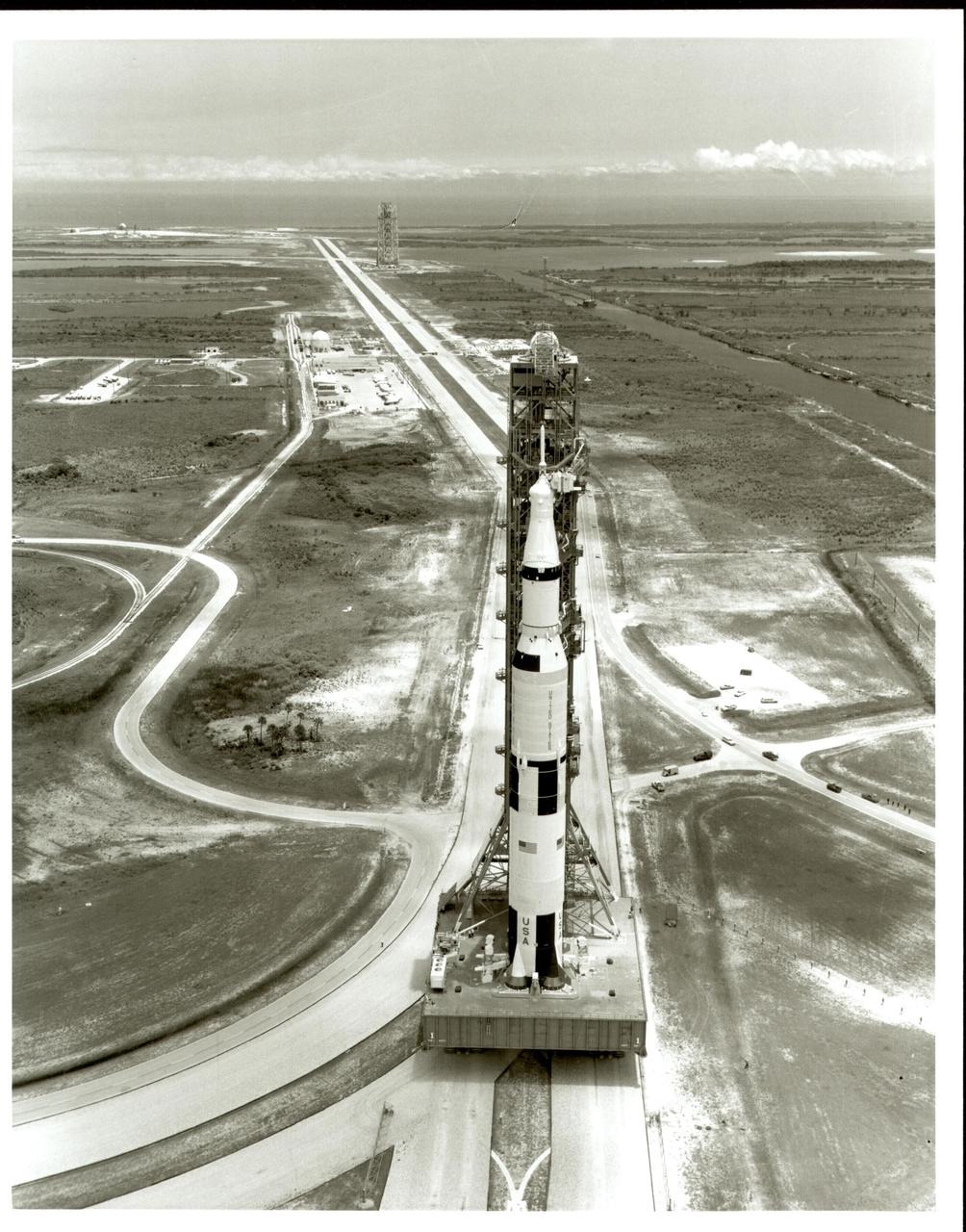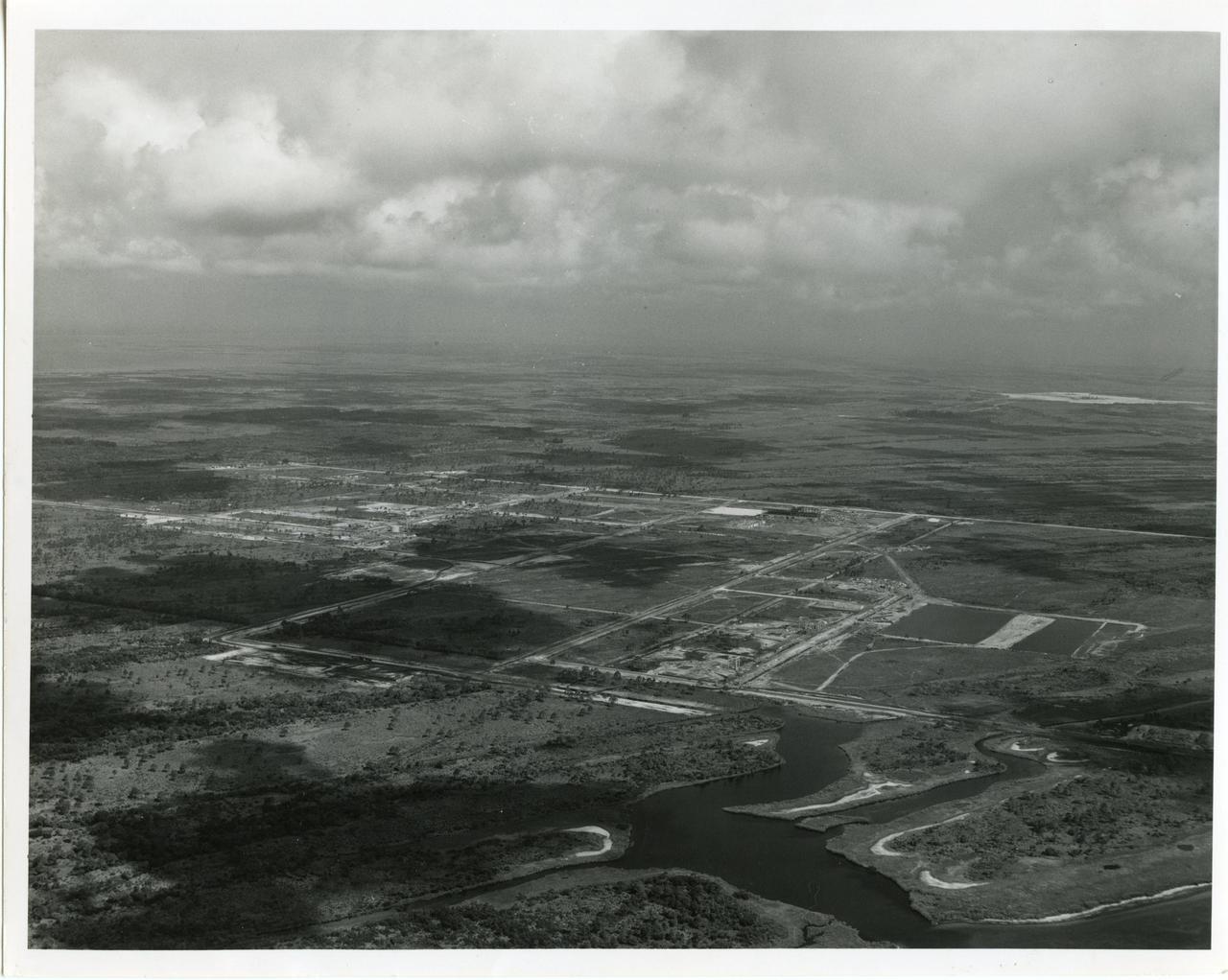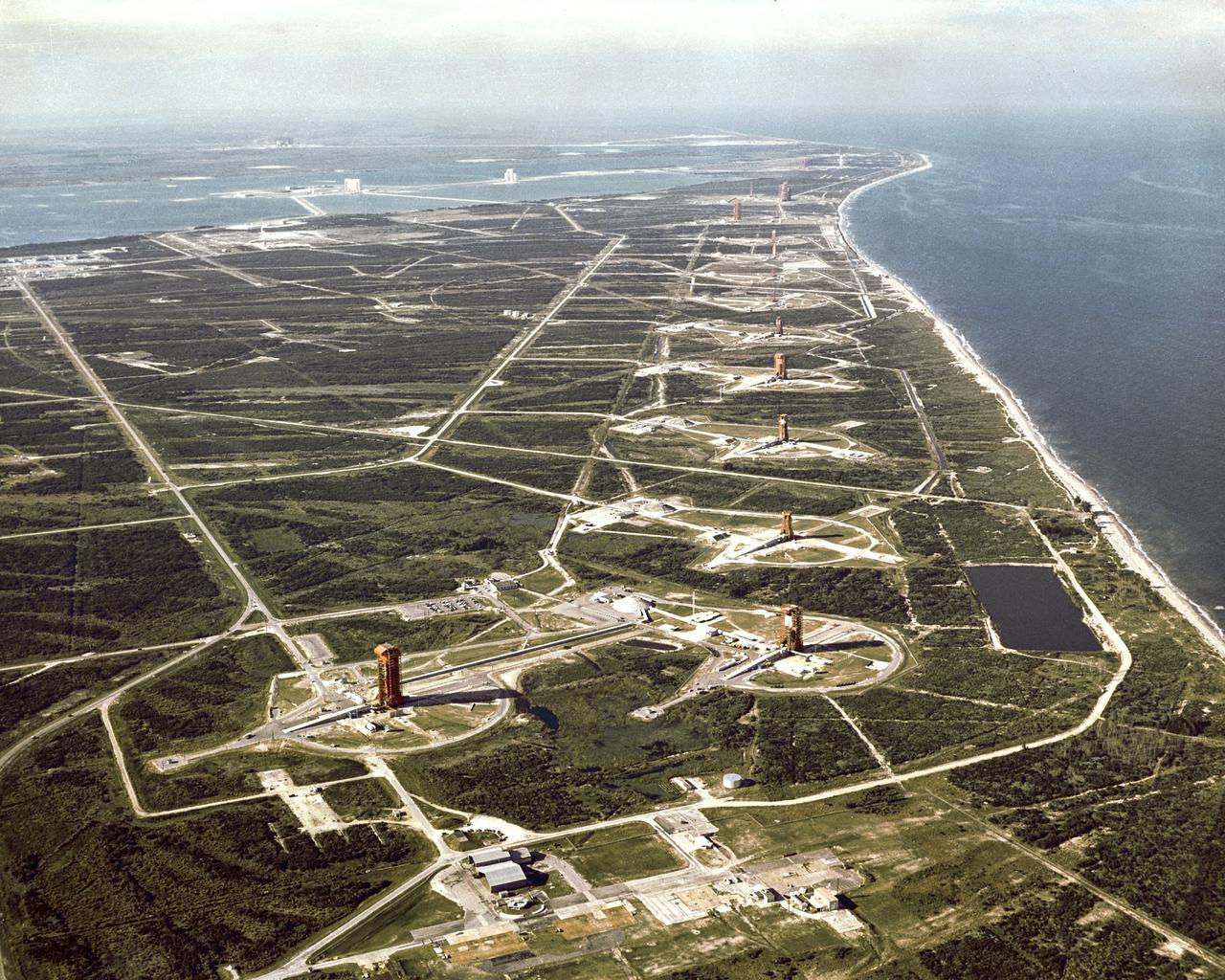
“Where the Land that Any Sane Man Wants Runs Out” Displacement and Disruption on Florida’s Space Coast
Technology’s Stories v. 7, no. 1 – DOI: 10.15763/jou.ts.2019.03.13.04
PDF: Reser_Displacement and Disruption
In 1968, the Public Affairs Office at Kennedy Space Center (KSC), headed by Gordon Harris, released an informational publication––more of a short monograph written by Harris himself––called “The Kennedy Space Center Story.” Chapter one, entitled “A National Resource,” situates the Spaceport in the specific environmental and historical context of its location on the east coast of Florida:
Uniquely a creation of the Space Age, the Center presents sharp contrasts between its physical setting, early history and the gargantuan engineering achievements which transformed palmetto scrub, marshland and citrus groves into the first operational Spaceport. Archeologists found traces of human activity before the Christian era, Indian burial mounds and refuse piles of later times, and indications of French and Spanish explorations before the birth of the Republic. Professor Charles Fairbanks of the University of Florida observed that the site was one of the places where Western civilization came to the New World; now it is destined to become the place from which our civilization goes out to other worlds.[1]
Representations of the space program’s encounter with nature and with the human past of the area foregrounded the immediacy and importance of the environment which surrounded the KSC. These images were used to justify the new high-tech uses to which the land in the KSC area was being put, distorting time and the human history of the area to naturalize “America’s Spaceport” as an inevitable and desirable use of a specific geographical place and environment.[2] The way that NASA, and outside observers, represented the environment and past of the area around the Spaceport contributed to space exploration being understood as the culmination of a progressive history of technological innovation, and elided or excused the displacement of people that was required to create the image of a Spaceport set in a tropical wilderness. The image of NASA’s most famous facilities were formed just as the space program of the 1960s was entering its prime. In many ways, human spaceflight was a project and a process whose real effects were largely earth-bound. Only a few men flew in space in these years, but hundreds of thousands of people were directly affected by the construction of new facilities. At KSC, the images of these effects, which millions of people consumed, relied on conventions and tropes taken not from science fiction or utopian visions of the future, but from the history of colonization and displacement.
Environmental Images
Among the more widely read accounts of the environment around KSC were those written by outside observers, writers and journalists who documented the space program. Norman Mailer, in his account of the Apollo 11 mission in Of A Fire on the Moon, introduced his readers to the Spaceport area by drawing an explicit contrast to the more sterile, corporate campus confines of the Manned Spacecraft Center.[3] In Mailer’s mind, the Florida coast was much more suited to the surreality of the space program precisely because the environment contrasted so sharply with the high-tech doings of KSC. Finally “loose in some real tropics,” he observed that
It is country beaten by the wind and water, … unspectacular country, uninhabited by men in normal times and normal occupations, for there are few trees and only occasional palms as ravaged and scabby as the matted backside of a monkey, a flat land of heat and water and birds … [It] is country for hunting, for fishing, and for men who seek mosquitoes; it was next to uninhabited before the war. Now, first spaceport––think on it! first spaceport…[4]

Courtesy NASA
Mailer thought it fitting that the absurdity of the space program was matched by the absurdity of building a spaceport in such a place. To him, the sterile, air conditioned environments of the Manned Spacecraft Center in Houston seemed more in line with what he saw as the overly cautious, stuffily bureaucratic management of the program. The image of rocket gantries rising up over a humid swamp was an aesthetic contrast that seemed to belie the rational, measured way that engineers and astronauts talked about their fantastical, cosmic mission.
Tom Wolfe, in The Right Stuff, knew better. He argued that the land on which the Spaceport was built was the same kind of land as Edwards Air Force Base in the Mojave desert, where many of the first astronauts had come up as jet test pilots. Of the beach in Florida, Wolfe wrote,
It was one of those bleached, sandy, bare-boned stretches where the land that any sane man wants runs out … and the government takes it over for the testing of hot and dangerous machines, and the kings of the resulting rat-shack kingdom are those who test them.[5]
Wolfe went so far as to cast the Cape as a literal evolutionary backwater, calling it “the sort of hopeless stone boondock spit where the vertebrates give up and the slugs and the No See’um bugs take over.”[6]
In 1964, The New York Times ran a piece called “Visit to the Three Cape Kennedy’s.”[7] The author, Robert Whalen, begins by expressing some disbelief that activities like the construction of the world’s largest building and the assembly and launch of rockets to the moon will take place in “an improbable setting of sand, water and scrub growth.”[8] Earlier that same year, another journalist had described the construction projects on the site as “[t]he free world’s greatest rocket center […] rising rapidly on once-useless Florida swampland to support America’s boldest adventure into space.”[9]
Both writers construct or portray the Cape as empty in some way. The construction of emptiness employed by these writers is a fundamental component of representations of the space program but also of American technology projects, such as the testing of nuclear weapons and the construction of military bases on islands held as territories by the United States, in the Cold War more generally. But these sites were not innately empty; they had in fact have to be emptied. Writing about the use of an empire of “networked” islands for such American Cold War technology projects, Ruth Oldenziel observes that “[c]olonized, recently colonized, or tribal lands had become [in the post-war period] the Western power’s favored testing grounds for nuclear weapons and other controversial technologies.” In these places, such as the Bikini Atoll or the deserts of Nevada, the U.S. engaged in a program of “‘emptying out’ spaces to fill them with ‘pristine,’ high-tech, prestigious,” technologies.[10]
A similar practice of emptying took place on the Florida coast when NASA arrived, a process made to seem natural by the types of environmental images I have related above. The space is portrayed as at once empty and useless but also as a desirable frontier in need of conquering. The frontier, as David Nye and others have argued, is the fundamental marker of technological meaning in American Culture.[11] These images about the wildness and emptiness of the environment around the space center suggest an uninhabited wilderness, primed for technological development in a frontier-minded culture of enthusiasm for spaceflight and Cold War heroics.
In 1961, NASA announced that it would be acquiring 88,000 acres of land on Merritt Island to build a permanent launch operations facility.[12] In addition to the existing launch facilities on the Cape, and the new facilities to be built on Merritt island, the major part of the installation would actually be unused land. The land acquired would need to include a huge exclusion zone devoid of people and property to protect against the possibility of large explosions that might occur with accidents involving launch vehicles. This particular emptiness, created by displacing the human residents in the area, was justified in part by environmental images that constructed the area as wild, only sparsely populated, unpleasant in climate, and filled with disagreeable wildlife.
While some of the land for NASA’s new Spaceport was purchased from individual landowners by the Army Corps of Engineers who managed the land acquisition, a good deal of it was acquired by condemnation. At least one family was forced to move multiple times as the scope of the land acquisition changed.[13] Harris described this process in The Kennedy Space Center Story as an amicable arrangement between landowners and the government, but doesn’t mention any condemnations. Harris is careful to address the aspects of community life, like citrus growing, that were displaced by NASA’s arrival and explain how the agency was able to replace them or accomodate them.[14] He notes that recreational areas were available for hunting and fishing, and that Brevard County maintained a stretch of seashore for public use.[15] But Harris also reiterates that the land was mostly wild and lists the various animals and plants that could be found there. He closes the first chapter of his history by noting: “This is the unique environment of almost virgin wild land contrasting sharply with Space Age facilities serving the needs of the national program today and in the future.”[16]
The “Antiquity” of the Spaceport
Another feature that many of these images have in common, and which compounds the work that environmental images do to set up a progressive lineage that NASA can lay claim to, is a distorted sense of time or temporality. Whalen, for instance, contrasted the Cape with the high-tech facilities NASA was building by describing the various features of its “antiquity” that one could still observe on the premises: “There are other vestiges of the Cape’s antiquity,” Whalen writes. “Along the oceanfront are crumbling restaurants and cottages that vacationers once used; no one has bothered to take them down.”[17]
The “crumbling” restaurants and cottages he describes were in fact largely taken over by NASA when they were acquired with the land for the space center. The agency used many for storage, training, and contractor laboratories. Some would have been in use by the former residents and businesses of Merritt Island as recently as three years before Whalen’s piece was published.
Norman Mailer also wrote about the antiquity of the space program. Of the very first launch structures used in the 1950s and early 60s, he writes,
…the early history of the Space Program is contained in these empty launch towers, now as isolated and private as grain elevators by the side of railroad tracks … Here in the cricket-dinning tympani of Florida’s dunes and marshes, the launching towers of rockets now obsolete … , stand already as monoliths and artifacts of a prehistoric period when rockets usually exploded in the first few hundred feet of their flight.
Courtesy NASA
Such accounts distort the temporality of these places, shifting “antiquity” forward to mean just a decade or two in the past, while the actual deep time of the Cape was rendered so distant as to make the past an abstraction that lends itself to be simplified, similar to linear progressive narratives like Harris’ colonial timeline. In this distorted temporality, the lives of people who lived in the area before NASA arrived could be easily dismissed as distant history, or more troublingly, enlisted into a progressive history of the area in which legacies of colonization and displacement were transformed into curiosities for consumption by the public alongside the technological spectacle of spaceflight.
The “Natives of the Spaceport Area”: Archeological Sites at KSC
In this distorted temporality, the deep human past of the area is enlisted to situate the Spaceport in a progressive, linear history of which it is the technological, and civilizational, apex. The internal newspaper of KSC, Spaceport News, published a number of items about the archaeological sites on KSC property, framing actual antiquity in a similar way to the compressed antiquity that Whalen and Mailer describe. A piece from 1968 begins: “The first missiles––with chipped flint nosecones––were launched from the land now owned by KSC some 3000 years ago by primitive Indians.”[18] The writer naturalizes the presence of such a high tech endeavor in a wild landscape by placing the Spaceport in a progressive history of technology from the arrowhead to the rocket.
In describing the period from 800 to 1000 A.D., the writer claims that “[f]rom the Spaceport south was one of the few areas in the world where people maintained a fairly civilized standard of living…” This framing suggests to the reader that this is a place with a history of innovation, and the Spaceport therefore fits right in. Projecting the name “Spaceport” back into the description of the area’s past makes a claim on the land and time in this place. The writer refers to the Ais people as “The natives of the Spaceport area,” as though they were the ones who had settled on NASA land, and not the other way around.[19]

As they are represented by Spaceport News, the archaeological sites near the Spaceport and the antiquity of the area are meant to be consumed by employees as an interesting feature of their workplace. Within the agency, however, the archaeological sites presented a challenge to NASA’s control of the land. In 1964, the Florida Anthropological Society’s expressed to NASA its interest in preserving a site called Ross Hammock. The forwarding note from the Department of the Interior notes that “we have no idea as to whether to proposal of the Society to study and develop the site fits into your program of land use.”[20] The correspondence contains maps and narratives about the importance of the site.[21]
In response to the FAS’s campaign to preserve the site, the agency drew up a set of restrictions that made it clear that while the site should be studied, NASA reserved all rights to the land for its own purposes. NASA and KSC were not sure what resources would ultimately be needed for space programs in the future, and so the right to develop or even build on land covered by research permits was essential to maintain. The restrictions called for NASA’s right to “construct such roads, buildings or other facilities of a permanent or temporary nature, and perform other such work on or across lands within the area covered by the permit as KSC may from time to time determine to be necessary or desirable in the interest of the United States…”[22]
The restrictions on the permit also indicate that any findings or objects recovered from the site would be handed over to the Florida State Museum, but only after they were made available to KSC for “temporary or permanent retention and public display in the Visitor Information Center or other repository at KSC.”[23] The restrictions also called for periodic updates to be made to the Public Affairs Office so that KSC could use that information for education and outreach. KSC also reserved the right to photograph the site and distribute images as it saw fit. This site was a resource for NASA in multiple ways, both related to the use of the land it was located on and the various cultural and media products that could be extracted from the site.
Conclusion
In 1963, at the height of construction of new facilities on Merritt Island, and amid outcry from citizens who wanted a justification for NASA’s huge exclusion zone, a wildlife refuge was established encompassing some 25,000 acres of NASA land.[24] It was a tidy solution for NASA which maintained the emptiness it needed as an exclusion zone, but conveniently “filled” that emptiness with now-desirable wildlife and and undeveloped, “pristine” wilderness in need of preservation. The “useless swamp” and “boondock spit” was now a national treasure.
The redesignation of the land as a wildlife reserve is another form of temporal compression. The land was portrayed as at once undeveloped and under federal protection; wild while simultaneously managed. It provided NASA and other observers with a flexible slate of meanings that could be turned and tweaked to make the Spaceport seem both inevitable and desirable, and pleasingly incongruous with its surrounding environment.
Like other Cold War technology projects sponsored by the United States, the expansion of the American space program and took up the creation and codification of different forms of “emptiness” to naturalize and justify its use of land. Playing up the contrast between the high-technology activities of NASA and the “primitive” environment surrounding KSC was a representational strategy that was incorporated into the Spaceport’s identity by its own Public Affairs Office, and taken up by influential observers whose accounts were widely read. NASA’s practices of land use and management generated meaning about spaceflight that is connected not to some larger cosmic purpose, but to the very tangible, earthly concerns of the environment, resources, people’s homes, and legacies of colonization and displacement.
Anna Reser is a Ph.D. Candidate at the University of Oklahoma, Department of the History of Science. She also co-founded and co-edits Lady Science, https://www.ladyscience.com/.
Copyright 2019 Anna Reser.
Notes
[1] Gordon L. Harris, The Kennedy Space Center Story (The Kennedy Space Center: Public Affairs Office, 1969): 1.
[2] The conventions of use for the names of various places were fairly fast and loose as far as journalists and observers were concerned in the 1960s. “The Cape” could mean anything from Cape Canaveral to Patrick Air Force Base, to Merritt Island. For the sake of clarity and brevity, I’ll refer to the NASA site as the Spaceport or Kennedy Space Center, and to landforms as Cape Canaveral or the Cape, Merritt Island, and the mainland. See also “The ‘Antiquity’ of the Spaceport,” below.
[3] This is my characterization of MSC, based in part on Louise A. Mozingo, Pastoral Capitalism: A History of Suburban Corporate Landscapes. (Cambridge: MIT Press, 2014).
[4] Norman Mailer, Of a Fire on the Moon. (New York: Little, Brown & Company, 1969): 50.
[5] Tom Wolfe, The Right Stuff (New York: Picador, 1979): 128.
[6] Ibid.
[7] The “three Capes,” that Whalen refers to are “the launch area, where the space story up to now has unfolded,” the new facilities that NASA was purpose-building for its own activities, and the community in the surrounding area. These three “Capes” are actually different landforms altogether, see note 2.
[8] Robert G. Whalen, “Visit to Three Cape Kennedy’s,” The New York Times, December 13, 1964. See also Neil M. Maher, Apollo in the Age of Aquarius (Cambridge: Harvard University Press, 2017): 97-103.
[9] Al Rossiter, Jr., Chicago Tribune, July 26, 1964.
[10] Ruth Oldenziel, “Islands: The United States as a Networked Empire,” in Gabrielle Hecht, ed., Entangled Geographies: Empire and Technopolitics in the Global Cold War (Cambridge:MIT Press, 2011): 22. I have limited this paper to discussion of Kennedy Space Center, but obviously Oldenziel’s argument has important consequences for thinking about other NASA projects like the Manned Space Flight Network.
[11] Lisa Messeri, Placing Outer Space: An Earthly Ethnography of Other Worlds (Durham: Duke University Press, 2016): 47.
[12] Kenneth Lipartito and Orville R. Butler, A History of the Kennedy Space Center (Gainesville: University Press of Florida, 2007): 58.
[13] William Barnaby Faherty, S.J., Florida’s Space Coast: The Impact of NASA on the Sunshine State (Gainesville: University Press of Florida, 2002): 27.
[14] Harris, The Kennedy Space Center Story.
[15] The conditions of public access to KSC land and facilities have always been in flux. I don’t go into detail here simply for brevity and clarity, and note only what Harris reports in 1968.
[16] Ibid., 7.
[17] NASA did get around to taking down many of these structures, but not until the late 1960s. A committee was formed in 1966 to survey temporary facilities and recommend them for preservation or disposal, but many were not slated for disposal until 1969. Joseph Hester, NASA Suggestions memo, December 8, 1966. Memo to the Director of Administrations, re Disposition of Temporary Buildings, March 11, 1969. Kennedy Space Center Files, Box 2, Ad Hoc Committee on Temporary Facilities 1969, National Archives and Records Administration, Atlanta.
[18] Spaceport News (September 26, 1968): 8. An archive of Spaceport News issues is available in hard copy at the National Archives in Atlanta.
[19] Ibid.
[20] The Ross Hammock site is located on the mainland near Oak Hill, on the shore of the Intercoastal Waterway and “consists of a complex of two very large sand burial mounds and a fairly extensive, but not extremely large, shell midden village area.” Ripley P. Bullen, Adelaide K. Bullen and William J. Bryant, Archaeological Investigations at the Ross Hammock Site, Florida (The William J. Bryant Foundation, American Studies Report Number 7, 1967): 1. Available online: https://palmm.digital.flvc.org/islandora/object/ucf%3A15242#page/006/mode/2up. I’d like to thank Dr. Kathleen Sheppard for help with materials related to the archaeological history of this area.
[21] Letter from Elbert Cox, Regional Director Department of Interior to Clarence Bidgood, Director of Facilities Engineering, Kennedy Space Center. February 27, 1964. Kennedy Space Center Files. Directorate of Design Engineering, Real estate Branch 1963-1970. (Box 2) Ad Hoc Temporary Facilities-Cape Data Collection Annex-Archaeological Sites. Archaeological Sites Ross Hammock. National Archives and Records Administration, Atlanta.
[22] “Proposed Conditions and Restrictions to be Attached to National Park Service Permit to University of Florida for Archeological Survey, Excavation and Collection at KSC, April 18 1966. Ibid.
[23] Ibid.
[24] Lipartito and Butler, A History, 99.

